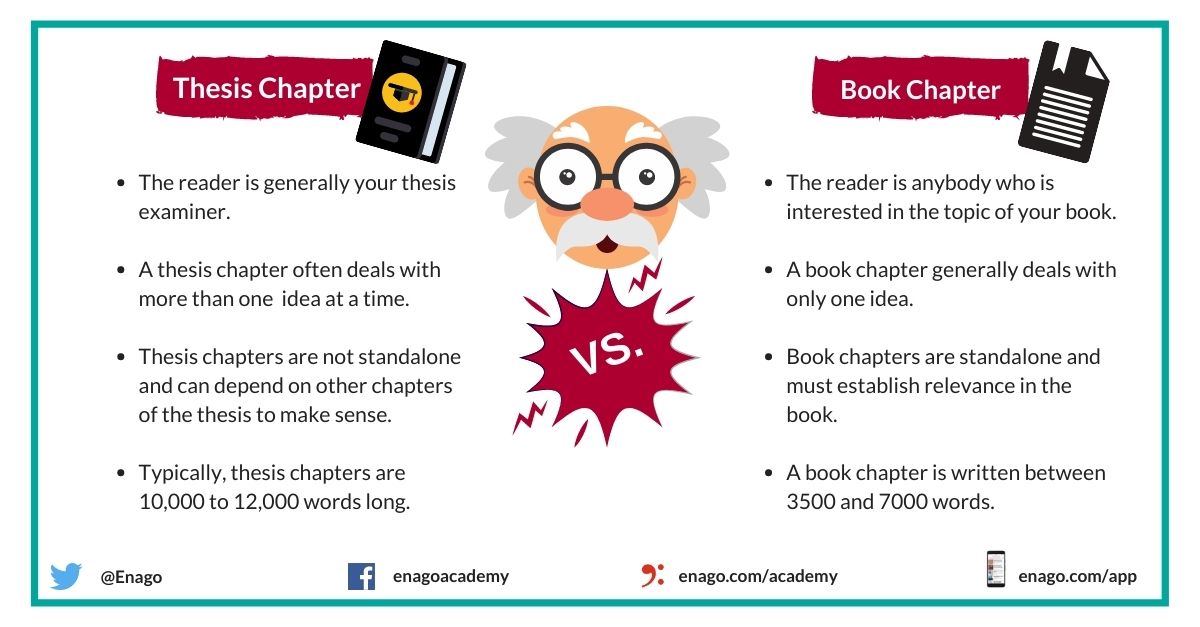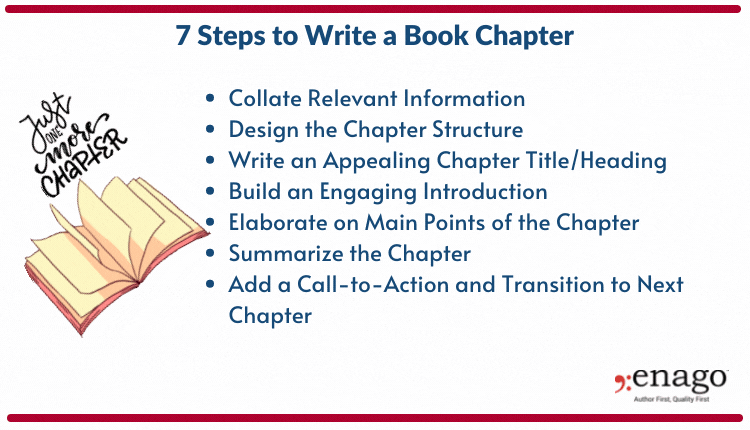7 Steps of Writing an Excellent Academic Book Chapter

Writing is an inextricable part of an academic’s career; maintaining lab reports, writing personal statements, drafting cover letters, research proposals, the dissertation—this list goes on. However, while these are considered as essentials during any research program, writing an academic book is a milestone every writer aims to achieve. It could either be your urge of authoring a book or you may have received an invite from a publisher to write a book chapter. In both cases, most researchers find it difficult to write an academic book chapter.
The questions that may arise when you plan on writing a book chapter are:
- Where do I start from?
- How do I even do this?
- What should be the length of book chapters?
- How should I link one chapter to the following chapter?
These questions are quite common when starting with your first book chapter. In this article, we’ll discuss the steps on how to write an excellent academic book chapter.
What is an Academic Book Chapter?
An academic book chapter is defined as a section, or division, of a book. These are usually separated with a chapter number or title. A chapter divides the overall book topic into topic-specific sections. Furthermore, each chapter in a book is related to the overall theme of the book.
A book chapter allows the author to divide their work in parts for readers to understand and remember it easily. Additionally, chapters help create structure in your writing for a better flow of ideas.
How Long Should a Book Chapter be?
Typically, a non-fiction book chapter should be small and must only include information related to one major idea. However, since a non-fiction /academic book is around 50,000 to 70,000 words, and each book would comprise 10-20 chapters, each book chapter’s word limit should range between 3500 and 7000 words.
While there aren’t any standard rules to follow with respect to the length of a book chapter, it may vary depending on the genre of your writing. However, it is better to refer your publisher’s guidelines and write your chapters accordingly.
Difference between a Book Chapter and Thesis Chapter
What makes a book excellent are the book chapters that it comprises. Thus, the key to writing an excellent book is mastering the art of writing a book chapter. You’d think you could write a book easily because you’ve already written your dissertation. However, writing a book chapter is not the same as writing your thesis.
The image below shares 5 major differences between a book chapter and a thesis chapter:

How to Write a Book Chapter?
As writing a book chapter is the first milestone in your writing journey, it can be overwhelming and difficult to garner your thoughts and put them down on a sheet at once. It takes time and effort to gain momentum for accomplishing this mammoth task. However, proper planning followed by dedicated effort will make you realize that you were worrying over something trivial.
So let us make the process of writing a book chapter easier with these 7 steps.

Step 1: Collate Relevant Information
How would you even start writing a chapter if you do not have the necessary information or data? The first step even before you start writing is to review and collate all the relevant data that is necessary to formulate an informative chapter.
Since a chapter focuses on one major idea it should not include any gaps that perplexes the reader. Creating mind-maps help in linking different sources of information and compiling them to formulate a completely new chapter. As a result, you can structure your ideas to help with your analysis and see it visually. This process improves your understanding of the book’s theme. More importantly, sort the ideas into a logical order of how you should present them in your chapter. This makes it easier to write the chapter without convoluting it.
Step 2: Design the Chapter Structure
After spending hours in brainstorming ideas and understanding the fundamentals that the chapter should cover, you must create a structured outline. Furthermore, following a standard format helps you stay on track and structure your chapter fluently.
Ideally, a well-structured chapter includes the following elements:
- A title or heading
- An interesting introduction
- Main body informative paragraphs
- A summary of the chapter
- Smooth transition to the next chapter
Even so, you may not restrict yourself to following only one structure; rather, add more or less to each of your chapters depending on your genre, writing style, and requirement of the chapter to maintain the book’s overall theme. Keep only relevant content in your chapter. Avoid content that causes the reader to go off on a tangent.
Step 3: Write an Appealing Chapter Title/Heading
How often have you put a book back on the book store’s shelf right after reading its title? Didn’t even bother to read the synopsis, did you? Likewise, you may have written the most impactful chapter, but what sense would it make if its title is not interesting enough. An impactful chapter title captures the reader’s attention. It’s basically the “first sight” rule!
Your chapter’s title/heading must trigger curiosity in the reader and make them want to read and learn more. Although this is the first element of a chapter, most writers find it easier to create a title/heading after completing the chapter.
Step 4: Build an Engaging Introduction
Now that you have captured the reader’s attention with your title/heading, it has obviously increased the readers’ expectations from the content. To keep them interested in your chapter, write an introduction that keeps them hooked on. You may use a narrative approach or build a fictional plot to grab the attention of the reader. However, ensure that you do not deviate from the main context of your chapter. Finally, writing an effective introduction will help you in presenting an overview of your chapter.
Some of the tricks to follow when writing an exceptional introduction are:
- Share an anecdote
- Create a dialogue or conversation
- Include quotations
- Create a fictional plot
Step 5: Elaborate on Main Points of the Chapter
Impactful title? Checked!
Interesting introduction? Checked!
Now is the time to dive in to the details imparting section of the chapter. Expand your opening statement and begin to explain your points in detail. More importantly, leave no space for speculation in the reader’s mind.
This section should answer the following questions of the reader:
- Why has the reader chosen to read your book?
- What do they need to know?
- Are their questions and doubts being resolved with the content of your chapter?
Ensure that you build each point coherently and follow a cohesive flow. Furthermore, provide statistical data, evidence-based information, experimental data, graphical presentations, etc. You could formulate these points into 4-5 paragraphs based on the details of your chapter. To ensure you structure these details coherently across the right number of paragraphs, calculate the number of paragraphs in your text here.
Step 6: Summarize the Chapter
As impactful was the entry, so should be the exit, right? The summary is the part where you are almost done. This section is a key takeaway for your readers. So, revisit your chapter’s main content and summarize it. Since your chapter has given a lot of information, you’d want the reader to remember the gist of it as they reach the end of your chapter. Hence, writing a concise summary that constitutes the crux of your chapter is imperative.
Step 7: Add a Call-to-Action & Transition to Next Chapter
This section comes at the extreme end of the book chapter, when you ask the reader to implement the learnings from the chapter. It is a way of applying their newly acquired knowledge. In this section, you can also add a transition from your chapter to the succeeding chapter.
So would you still have jitters while writing your book chapter? Are there any other strategies or steps that you follow to write one? Let us know in the comments section below on how these steps helped you in writing a book chapter.










Excellent!
Thank you I have got a full lecture for sure
Thank for the encouraging words
You have demystified the act of writing a book chapter. Thank you for your efforts.
Very informative
It has really helpful for beginners like me.
Very impactful and informative. Thank you 😊
Very informative and helpful to beginners like us. Thank you.
Thanks for this very informative article
You have made writing a book chapter seem very simple. I appreciate all of your hard work.
It really helps and inspire me to finally continue with my writing guidance book
THis is very useful. Some examples would be very useful.